Ever wanted to create a passwordbased program for the arduino?`
Installing Arduino libraries can be done in three different ways: manually installing the files, importing a ZIP file, and using the library manager. Two of these methods can be done with menu options. But for manual installation, you have to locate the library’s files and place them into the Arduino “libraries” folder.

Download: DS1307.zip (Filesize is 373.64 KiB. Downloaded 54411 times) A few demos are included to demonstrate most of the functions. This is a multi-platform library that will work with several different development board types. Starting with version 1.0.5, you can install 3rd party libraries in the IDE. Do not unzip the downloaded library, leave it as is.In the Arduino IDE, navigate to Sketch Include Library Add.ZIP Library. At the top of the drop down list, select the option to 'Add.ZIP Library'. Return to the Sketch Include Library menu. ArduinoLSM9DS1 - library to use the LSM9DS1 9 axis IMU available on the Arduino Nano 33 BLE and the Arduino Nano 33 BLE Sense. Arduino Nano 33 BLE Sense PDM - library to use the digital microphone MP34DT05, our library PDM can be used also with our ArduinoSound library. I discovered in a recent project involving an Arduino microcontroller that there was no method to change PWM frequency without directly manipulating low-level memory. As far as I can Google, there is no general purpose library that can change PWM frequencies on Arduino Microcontrollers. The internet is full of partial examples and code snippets for changing PWM frequency, but in the end I.

Tired of using arrays of characters?
This is the answer.
(Don’t you love commercials? ;))
http://www.arduino.cc/playground/Code/Password - Download
Simple serial monitor example.
#include <Password.h>
Password password = Password( “1234” );
byte currentLength = 0;
void setup(){
Serial.begin(9600);
Serial.println(“Try to guess the password!”);
Serial.println(“Reset with ! evaluate with ?”);
Serial.print('Enter password: ');
}

void loop(){
if (Serial.available()){
char input = Serial.read();
switch (input){
case ‘!’: //reset password
password.reset();
currentLength = 0;
Serial.println('tPassword is reset!');
break;
case ‘?’: //evaluate password
if (password.evaluate()){
Serial.println('tYou guessed the correct password!');
}else{
Serial.println('tYou did not guess the correct password!');
}
break;
default: //append any keypress that is not a ‘!’ nor a ‘?’ to the currently guessed password.
password.append(input);
currentLength++;
Arduino Library Download
//Print some feedback.
Serial.print('Enter password: ');
for (byte i=0; i<currentLength; i++){
Serial.print(’*’);
}
Serial.println();
}
}
}
Lcd Arduino Library Download
Only a 1234? (or !1234? if you need to reset first) sequence will get you to the ‘‘You guessed the correct password!’’ message.